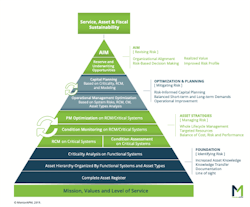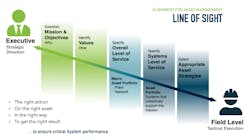Four asset management steps for wastewater utilities
The most successful wastewater and water providers have been the ones that established effective asset management programs.
Utility asset management can be intimidating, with numerous factors to consider and many pieces of the puzzle to put together. The most common question from utilities is, “Where do we start?”
To navigate these complexities, it is essential to keep the big picture in mind and focus on four fundamental pillars:
- Seeking alignment across the organization,
- Making risk-based decisions,
- Extracting maximum value from assets; and
- Having strong corporate leadership and support.
What is asset management anyway?
Asset management is the coordinated activity of an organization to realize value from its assets. More simply put, asset management is doing the right things, in the right order, for the right reasons, to get the right results.
Starting with a focus on the following four key principles of asset management will direct utilities to the right things to do first.
1. Strategic and organizational alignment
A successful asset management program connects the overall mission and strategic outlook to the daily execution of asset care. Establishing this line of sight from the mission to daily work orders is dependent on getting everyone on the same page and working towards the same goals.
Organizational alignment needs to be both vertical from the executive suite to the field level, and horizontal, across all divisions such as purchasing, accounting, operations, legal and finance.
To achieve both horizontal and vertical alignment, it is important to involve everyone from the executive suite to the field level in the asset management program. While the executive suite focuses on overall objectives, policies, and governance, middle management and field crews put tactical initiatives into practice. When senior management clearly articulates the organization's mission and values, middle and field level staff will have something to work with.
These employees are the best equipped to understand the portfolio of assets, their current operation, and their status. A review of the assets and infrastructure against the organization's values and objectives can evaluate which assets and systems are critical and where there is exposure to risk.
Every division in a utility looks at the same portfolio of assets from a different angle. Being intentional about getting everyone involved in your asset management program will break down silos and build consensus on priorities.
2. Understand risk and make risk-based decisions
Risk management is central to all aspects of an asset management program. First, identify risk before managing and mitigating it. In effective asset management, leaders should be making risk-based decisions to balance competing demands for maintaining performance, increasing efficiency and avoiding risk. The ultimate aim of an asset management program is to revise the risk profile of the utility for improved sustainability and resiliency.
Simply put, risk is the likelihood that something will go off plan and undermine the level of service provided. It is important to define the level of service and how to achieve it. Considerations at this stage include safety for both to staff and the public, environmental responsibility, meeting regulatory obligations as cost effectively as reasonably possible, and doing so in a way that reflects the expectations and values of the community served.
A criticality analysis can help identify critical systems and assets and assess the risk associated with them. This information is essential in deciding whether some assets or systems require capital investment, heightened monitoring, or attention to mitigate risk.
Accurately identifying and understanding criticality and risk is foundational to the success of an asset management program and securing the level of service desired. Not to mention, completing a criticality analysis with a cross-functional team can be highly beneficial for reinforcing alignment across your organization.
3. Maximum value from assets
Getting the maximum value from assets is really about applying the best asset strategies to balance cost, risk and performance to extend asset life and maintain service delivery. Following a criticality analysis, asset managers will have a clear set of priorities for where to target resources for activities like condition assessment, continuous monitoring and preventative maintenance optimization.
To extract maximum value from the assets, it is important to measure success and outcomes as well. Some helpful metrics to start with include the ratio of cost to repair an asset versus purchasing a new one, minimum performance targets, appropriate monitoring of critical and expensive-to-repair assets and avoiding consequential failures. These KPIs should be added to and refined over time. It is also very important to maintain a whole lifecycle management outlook to effectively manage the total cost of ownership.
To make decisions on where to spend money in the immediate term, it is important to understand critical assets and risks clearly. This understanding allows one to decide what can be deferred or ignored, to sharpen focus and produce to significantly improved outcomes.
4. Leadership buy-in is key to success
If there is one clear predictor for the ultimate success of asset management programs, it is leadership. When senior leadership is directly involved and supporting the asset management effort, the programs endure and achieve better outcomes. Without executive sponsorship, the effort tends to flounder and lose momentum. MentorAPM has had the privilege of working with some amazing utility leaders who are casting a vision for what their asset management program is going to achieve and who are putting the resources against it.
Recently, the MentorAPM team spoke with a head engineer at a county wastewater department in California who said, “My motivation for building a better asset management system is to get our staff to focus on what’s important in our facilities to keep costs under control (value) and avoid surprises (risks).”
This engineer perfectly summed up the foundation for building an asset management program: get everyone on the same page, understand risk, get maximum value, and exercise leadership to support the effort. Placing focus on these four pillars of asset management first will build an efficient and agile organization that knows where it is headed and can respond to whatever challenges it faces.
What asset management is not
Asset management is not software
Software is just a tool to support an overall asset management strategy and program. EAM/CMMS software is only going to be as effective as the asset management plan it supports. This is one of the reasons so many EAM implementations fail or fail to deliver expected results.
Asset management is not a better maintenance plan
Maintenance is just one part of the asset lifecycle. Asset management is a coordinated set of business practices that covers the whole lifecycle of an asset from design to acquisition through operation and maintenance to disposition. Asset management is a strategic discipline that includes the tactical efforts of managing assets, such as maintenance.
Asset management is not condition assessment
Too often when a water or wastewater utility talks about their asset management plan, what they are really describing is their condition assessment plan for their network. Condition assessments are vitally important and deliver an excellent return, but again, they are just one part of the big picture of asset management.
Outcomes to expect from an asset management program
Implementing an asset management program will deliver positive results for a utility. Managers and administrators will be able to make better decisions for better outcomes. Simply completing a criticality analysis will allow them to make adjustments to O&M plans for almost immediate returns.
Here are some benefits utilities should expect:
- Improved asset availability and reliability;
- Increased LOS security;
- Stable budgets and improved financials;
- Knowledge preservation and transfer from your retiring workforce to the next generation;
- Ability to do more with less;
- Improved operation of critical infrastructure;
- Consistent meeting of KPIs and compliance with regulatory standards;
- Stronger health and safety records; and
- Improved utility risk profile.
About the Author
Tacoma Zach
CEO and co-founder of MentorAPM
Tacoma Zach, P.Eng, is the CEO and co-founder of MentorAPM and a member of the US TAG to ISO 55000 the international asset management standard. MentorAPM is an enterprise asset management system and CMMS that helps water and wastewater utility managers understand their utility, align their teams and do more with less. Zach can be reached at [email protected].


